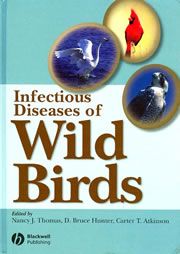야생조류 전염병에 대한 방대한 내용
2007년 최신판입니다.
VIN.com의 북리뷰에서 당당히 별4개를 받았읍니다.(일반적으로 괜찮다고 평가되는 경우가 별3개를 받습니다)
| Infectious Diseases Of Wild Birds Nancy J. Thomas, DVM, MS, DACVP
D. Bruce Hunter, DVM, MSc Carter T. Atkinson, Ph.D.
This book started out as a long-overdue second edition of the classic 1971 text, Infectious and Parasitic Diseases of Wild Birds, but it grew so large that the parasitic diseases portion had to be dropped, hopefully to be picked up at a later date in a separate volume. This new book ably serves as a companion text to the other recently updated editions of Infectious Diseases of Wild Mammals (3rd edition) and Parasitic Diseases of Wild Mammals (2nd edition), both published in 2001 and both previously reviewed on VIN.
The book is divided into three main sections: viral diseases (including Newcastle disease, duck plague, avian influenza, and pox), bacterial and fungal diseases (including avian cholera, salmonellosis, avian tuberculosis, chlamydiosis, and aspergillosis), and biotoxins (including botulism, mycotoxins, and algal toxicosis). Many of the individual chapters are updates from the original book, but several diseases (such as circovirus, papillomavirus, and polyomavirus) not covered in the first book are included here.
The book benefits greatly from having every chapter follow the same general outline: disease history, distribution, host range, etiology, epizootiology, clinical signs, pathogenesis, pathology, diagnosis, public health concerns, domestic animal health concerns, management implications, control, and treatment. Treatment is not emphasized.
Most chapters make fine use of tables, especially of species lists most commonly affected by that particular disease.
I strongly recommend this much-anticipated text to any veterinarian, biologist, ecologist, or zoologist who works with birds (especially the wild species). This book would also find a good home in the library of any nature or wildlife center.
Table of Contents
Viral Diseases
Bacterial and Fungal Diseases
Biotoxins
Blackwell Publishing, 7 x 10 inch format, hardcover. 496 pages, 73 illustrations. $89.99 US. ISBN 10:0813828120.
| ||||||
Infectious Diseases of Wild Birds
Edited by: Nancy J. Thomas (US Geological Survey), D. Bruce Hunter and Carter T. Atkinson
Description
Free-living birds encounter multiple health hazards brought on by viruses, bacteria, and fungi, some which in turn can significantly impact other animal populations and human health. Newly emerging diseases and new zoonotic forms of older diseases have brought increased global attention to the health of wild bird populations. Recognition and management of these diseases is a high priority for all those involved with wildlife.
Infectious Diseases of Wild Birds provides biologists, wildlife managers, wildlife and veterinary health professionals and students with the most comprehensive reference on infectious viral, bacterial and fungal diseases affecting wild birds. Bringing together contributions from an international team of experts, the book offers the most complete information on these diseases, their history, causative agents, significance and population impact. Focusing on more than just treatment, special emphasis is given to disease processes, recognition and epidemiology.
--The most complete reference on infectious viral, bacterial and fungal diseases in wild birds
--Emphasis on disease processes, epidemiology and recognition
--Offers perspective on the global significance of these diseases and their population impact
--Written by leading researchers and experts from around the world
TopTable of Contents
Viral Diseases
Chapter 1: Newcastle Disease
Chapter 2: Arbovirus
Chapter 3: Avian Herpesviruses
Chapter 4: Duck Plague
Chapter 5: Avian Influenza
Chapter 6: Avian Pox
Chatper 7: Orthoreoviruses
Chapter 8: Avian Adenoviruses
Chapter 9: Circovirus
Chapter 10: Papillomaviruses and Polyomaviruses
Chapter 11: Retroviral Infections
Bacterial and Fungal Diseases
Chapter 12: Avian Cholera
Chapter 13: Salmonellosis
Chapter 14: Avian Tuberculosis
Chatper 15: Avian Chlamydiosis
Chapter 16: Mycoplasmosis
Chapter 17: Erysipelas
Chapter 18: Borrelia
Chapter 19: Tularemia
Chapter 20: Aspergillosis
Biotoxins
Chapter 21: Avian Botulism
Chapter 22: Mycotoxicosis
Chapter 23: Algal Biotoxins
TopAbout the Author
Nancy J. Thomas, DVM, MS, Diplomate, American College of Veterinary Pathologists, is an endangered species specialist for the U.S. Geological Survey, National Wildlife Health Center. She has more than 20 years of experience in diagnostic pathology and research on wild bird diseases.
D. Bruce Hunter, DVM, MSc, is a professor in the Department of Pathobiology, Ontario Veterinary College, University of Guelph. His specialty encompasses avian, fur-bearing, and wildlife pathology and ecosystem health. His research interests have included infectious diseases commercial poultry, West Nile Virus in owls, and diseases of mink.
Carter T. Atkinson, Ph.D. is a research microbiologist with the U.S. Geological Survey, Pacific Island Ecosystems Research Center. His research focuses on protozoan parasites of vertebrates, particularly birds, with a recent emphasis on the effects of introduced avian malaria on Hawaiian forest birds.
